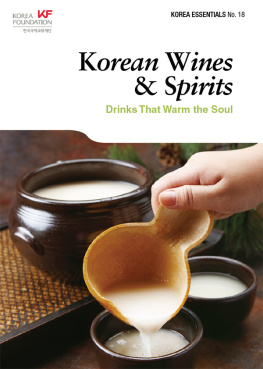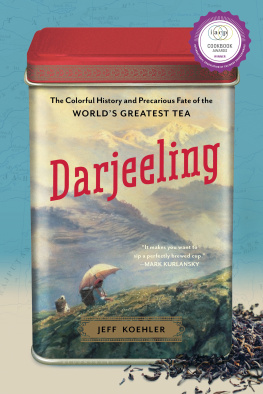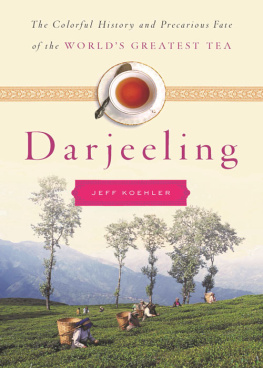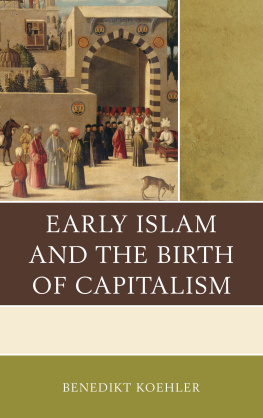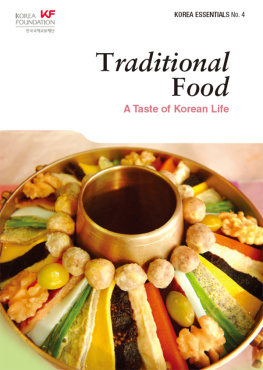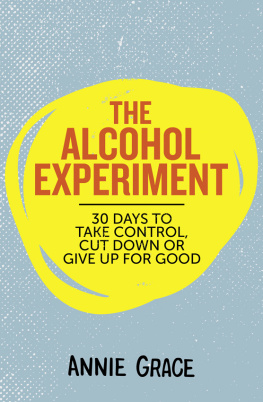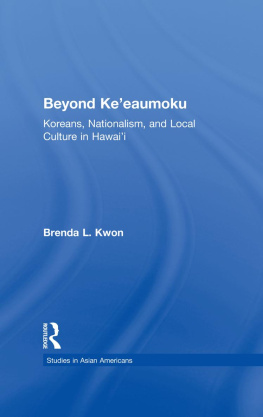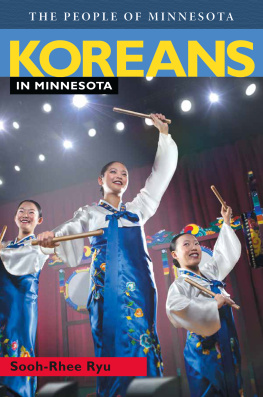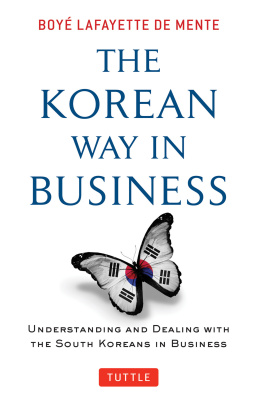Korean Wines & Spirits
Drinks That Warm the Soul
KOREA ESSENTIALS No. 18
Korean Wines & Spirits
Drinks That Warm the Soul
Copyright 2014 by The Korea Foundation
All Rights Reserved.
No part of this book may be reproduced or utilized in any form or by any means without the written permission of the publisher.
First Published in 2014 by Seoul Selection
B1 Korean Publishers Association Bldg., 6 Samcheong-ro, Jongno-gu, Seoul 110-190, Korea
Phone: (82-2) 734-9567
Fax: (82-2) 734-9562
Email:
Website: www.seoulselection.com
ISBN: 978-1-62412-058-9
INTRODUCTION
Koreans have been producingand drinkingalcohol for centuries. Along with song and dance, alcohol has always been an essential part of the Korean joie de vivre.
Koreans drink a lot, but they dont drink just to get drunk. Of course, Koreans enjoy alcohol as a means to make merry and build cohesion between family, friends and coworkers. But alcohols place in Korean culture goes far beyond that. Alcohol has historically also been a medicine and a means to preserve perishable ingredients. It even has a place in the sacred rites of Koreas Confucian society, including the all-important ancestral remembrance rites. Because of the important role alcohol has played in their society, Koreans have developed sophisticated brewing techniques to produce a wide range of alcoholic tipples. These techniques serve both to preserve the health benefits of the medicinal herbs often used as ingredients, and minimize the harm alcohol can do, such as hangovers.
When people think of Korean alcohol, they usually think of soju and makgeolli, the countrys best-known beverages. The world of Korean alcohol is extremely varied, however, with each province producing its very own firewater based on local geographical and climactic conditions. Still, Korean liquors do tend to share several key characteristics.
For starters, Korean alcohol tends to be fermented several times: Some 70 percent of Korean alcoholic beverages are fermented at least twice. And while the basic ingredientsrice, water and yeastare usually the same, how those ingredients are prepared can yield strikingly different results. Rice, for instance, can be prepared in eight different ways before being turned into alcohol, including as a porridge and a variety of rice cakes. The range of drinksand according to studies, there are about 130 traditional beverages in Koreais made all the more diverse by the fact that virtually every household used to brew its own alcohol, either for ceremonial or household use.
Moreover, over 50 percent of traditional Korean alcohols are prepared only in specific seasons. While some drinks need to be brewed at specific temperatures, many require ingredients such as flowers and fruits that are available only at certain times of year. Indeed, Koreans of old would enjoy the beauty of seasonal change by drinking tipples associated specifically with those times of the year.
Finally, Korean alcohol wasand to a large extent, still isviewed as medicine. It makes use of a dizzying array of medicinal herbs, plants and roots, and is prepared specifically to preserve the beneficial health effects of the individual ingredients. This was especially the case in the Joseon Dynasty, when the development of medicine and the proliferation of medical knowledge allowed families to brew their own medicinal wines.

My friend, if you have some wine at
home
be sure to invite me
When the flowers at my house
bloom
I will call you
Lets discuss ways of forgetting
the worries of one hundred years.
- Kim Yuk (15801658)

A lcohol is one of the oldest drinks produced by humans, and every culture has myths associated with its origin. However, because fermentation occurs naturally in any fruit or grain containing sugar, early humans probably discovered these natural intoxicants by accident and, finding them to their liking, began to produce them.
It is believed that early Koreans used grain as the main ingredient for making alcoholic beverages, since agriculture became well-developed early in Koreas history. Early Koreans probably waited for the grain to decay and naturally turn into liquor, chewed the grain so that saliva would hasten its fermentation or soaked it in water to make malt. A number of Korean wines and other alcoholic drinks can be traced back to a period before the rise of the three kingdoms of Silla, Goguryeo and Baekje.
THREE KINGDOMS PERIOD
By the Three Kingdoms Period (1st century B.C.A.D. 7th century), grain wines fermented with yeast were already quite popular. In fact, it was recorded that wine was such an integral part of life that the people of the ancient states of Ye, Buyeo, Jinhan, Mahan and Goguryeo wined, dined and sang incessantly during seasonal festivals like Dongmaeng, an autumnal celebration of the gods held in Goguryeo.
The people of Goguryeo (37 B.C.A.D. 668) produced a fine wine known as chiju, for which they earned a reputation among the Chinese for their fermentation expertise. Inbon, a wine expert from Baekje, introduced the technique of making grain wine to Japan and attained a status on a par with Bacchus as a god of wine. Although ancient documents indicate that chiju and other wines called nangnangju, mion and yorye were consumed at the time, there is no record of how they were made.
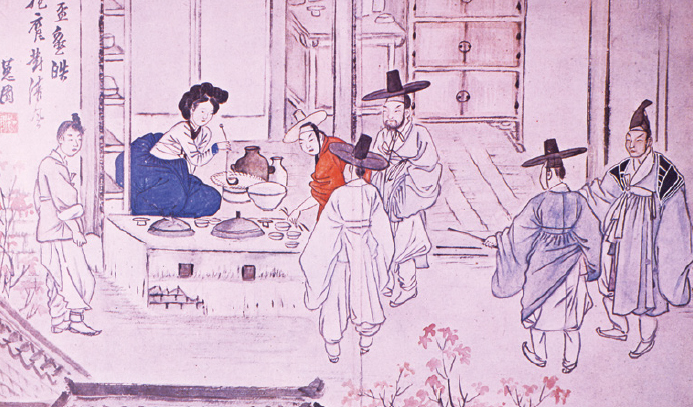
Holding a Drinking Bout (Shin Yun-bok, 18th century, Kansong Art Museum) depicts a proprietor handing out liquor to her guests at a jumak, or a tavern.
Techniques for producing fermented alcohol with yeast or malt were well established by the late Three Kingdoms Period. The wine-making techniques of Goguryeo were exported to China and led to the creation of Korean wines called goryeoju and gogaju. In the meantime, sillaju and nangnangju became the most popular alcoholic drinks in the Silla Kingdom (57 B.C.A.D. 935). According to legend, King Muyeol (r. 654661), who unified the Korean Peninsula in the seventh century, ate two meals a day, consuming six bushels of rice, six gallons of wine and 10 pheasants.
Although the names of wines associated with Koreas ancient kingdoms have been found in historical records, no descriptions of their ingredients or fermentation techniques have been found. Various kinds of grain wines originated during the Unified Silla period (668935), with refined grain wines gaining popularity among the aristocracy. Records show that wines such as these were served during a formal dinner hosted by King Sinmun (r. 681692) in 683.
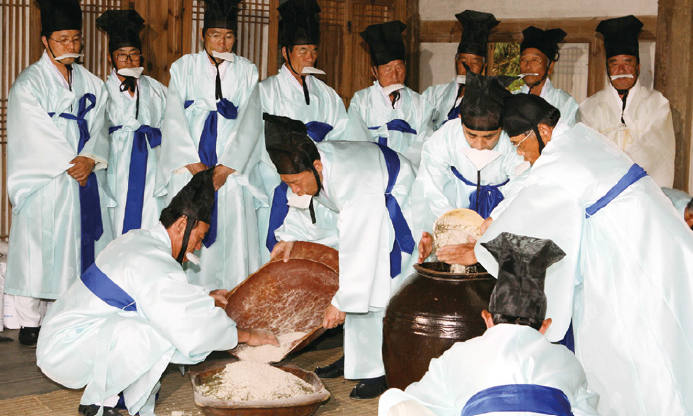
Gangneung Danoje festival is a local folk ritual passed down from the ancient days in Gangneung, Gangwon-do, and the festival begins with brewing a liquor offering for God.
Next page
